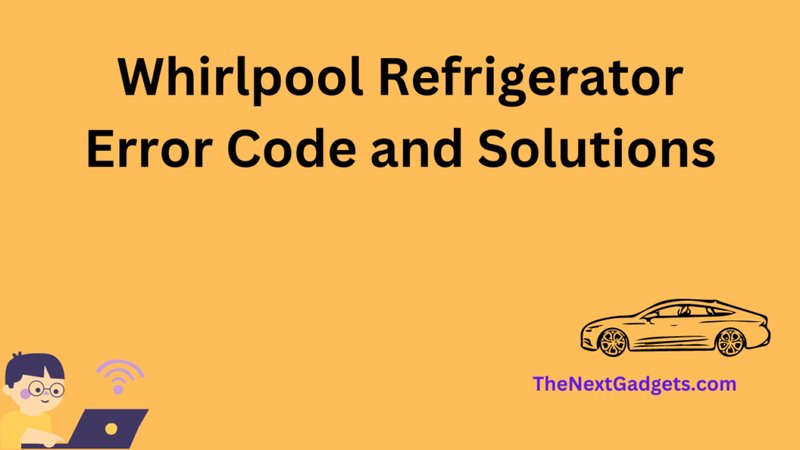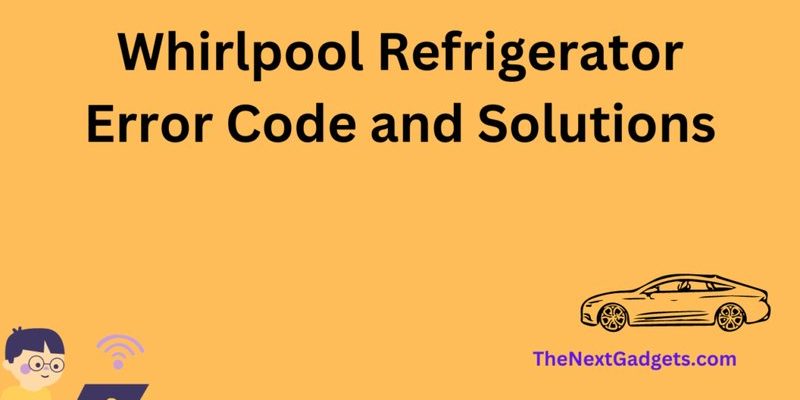
Imagine your refrigerator as a busy hub in your home, working tirelessly to keep your food fresh and your drinks cool. When it displays an E2 error, it’s akin to a little red flag waving to get your attention. This code indicates an issue with one of the sensors inside your fridge, which are crucial for maintaining the correct temperature. Just like how your body needs to maintain a steady temperature for everything to work smoothly, your fridge relies on these sensors to function properly. So, let’s dive a bit deeper into what causes this pesky error and what you should do about it.
Understanding the Whirlpool Refrigerator Error Code E2
The E2 error code is basically your refrigerator’s way of communicating that there’s a hiccup in the sensor system. In technical terms, it specifically relates to a malfunction of the freezer sensor, which is responsible for monitoring the temperature inside your freezer. Think of this sensor like a thermostat for your fridge. If it’s not working properly, your freezer might find it difficult to know when to cool more or ease off, just like when a thermostat in your home isn’t working right — you might find it too hot or too cold.
So, what exactly happens that leads to the E2 error? Well, sensors can struggle for a variety of reasons. They could be dirty, disconnected, or simply faulty. It’s as if there’s a tiny roadblock in the way of your fridge’s ability to regulate and maintain optimal temperatures. The result? Fluctuations in temperature that could potentially lead to inefficient cooling or, in the worst-case scenario, spoilage of your stored food items.
But there’s no need to panic. Your fridge isn’t going to explode, and your groceries aren’t going to spoil overnight. However, it does mean you should consider taking action sooner rather than later. Ignoring the E2 error could lead to more serious issues down the line, such as higher energy bills due to your fridge working overtime, or even permanent damage to your appliance.
What You Should Do When You See the E2 Error Code
So now that you know what the E2 error is all about, what’s the next step? First things first, don’t ignore it. Think of it as a whisper from your fridge that it needs a little TLC. Checking the sensor should be your top priority. You might not need to be a professional technician to tackle this; a bit of patience and some basic tools should do the trick.
Start by locating the sensor. Usually, it’s nestled inside the back panel of the freezer. If you’re unsure where to look, consulting your refrigerator’s manual can be extremely helpful. Once you’ve located it, inspect it for any visible signs of damage or disconnection. Sometimes, simply ensuring it’s firmly in place can resolve the issue. It’s a bit like making sure a headset is properly plugged into your phone—sometimes that’s all it takes to fix the static.
If everything looks fine but the code persists, you might have to replace the sensor. Don’t worry; this doesn’t mean you need to be an electronics expert. You can find replacement parts online or at local appliance stores. Just make sure to match the part number with your model to ensure compatibility. Replacing it is generally straightforward, like changing a light bulb, but if you’re unsure, you can always consult a professional.
Preventing Future Error Codes
Once you’ve resolved the E2 error (hooray!), the next step is ensuring it doesn’t happen again. Here’s the deal: regular maintenance can significantly reduce the risk of error codes. Just like a car needs oil changes and tire rotations, your refrigerator benefits from a bit of routine care.
Start by keeping your fridge clean. Dust and debris can accumulate over time and potentially interfere with sensors or other components. Wipe down surfaces regularly and vacuum around the back where the compressor resides. This is similar to keeping a computer dust-free to prevent overheating.
Another tip is ensuring proper air circulation inside the fridge and freezer. Overloading them can block air vents and lead to uneven cooling, much like stuffing a suitcase to the brim can make it difficult to close. Allow space between items so cool air can circulate freely.
Lastly, pay attention to how your fridge is used. Frequent door openings, especially in warm environments, can make it work harder, leading to potential issues. Be mindful of how often and how long you leave the door open.
Is it Ever Okay to Ignore Error Codes?
You might be wondering, “Is it ever safe to just ignore these codes?” Well, in general, ignoring error codes is not advisable. They’re there for a reason, much like traffic lights directing you on the road — fail to follow them and you might find yourself in a jam. While your fridge won’t immediately stop working if you ignore an error code, overlooking it could lead to gradual inefficiency or, worse, a sudden breakdown.
Sometimes, it might seem like the error is a false alarm, especially if everything appears to be functioning normally. However, even if it seems insignificant, think of it as your fridge attempting to communicate a potential concern. Addressing errors promptly can save you time and money in the long run, much like catching a small leak before it turns into a flood.
In summary, ignoring the E2 error code isn’t recommended. Engaging with it proactively can enhance your fridge’s performance and extend its lifespan. If tackling the issue on your own feels daunting, don’t hesitate to reach out to professional services for guidance. And remember, keeping your fridge in top shape is a lot like maintaining any valuable tool in your home — a little attention goes a long way in ensuring it serves you well for years to come.
